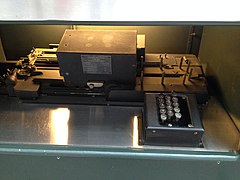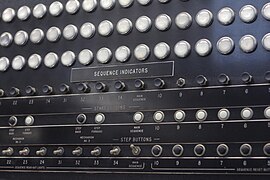
The analytical engine was a proposed digital mechanical general-purpose computer designed by English mathematician and computer pioneer Charles Babbage. It was first described in 1837 as the successor to Babbage's difference engine, which was a design for a simpler mechanical calculator.

Computer science is the study of computation, information, and automation. Computer science spans theoretical disciplines to applied disciplines. Though more often considered an academic discipline, computer science is closely related to computer programming.

The history of computing hardware covers the developments from early simple devices to aid calculation to modern day computers.

BARK was an early electromechanical computer. BARK was built using standard telephone relays, implementing a 32-bit binary machine. It could perform addition in 150 ms and multiplication in 250 ms. It had a memory with 50 registers and 100 constants. It was later expanded to double the memory. Howard Aiken stated in reference to BARK "This is the first computer I have seen outside Harvard that actually works."
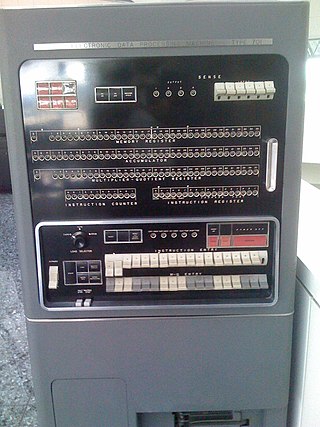
The IBM 701 Electronic Data Processing Machine, known as the Defense Calculator while in development, was IBM’s first commercial scientific computer and its first series production mainframe computer, which was announced to the public on May 21, 1952. It was designed and developed by Jerrier Haddad and Nathaniel Rochester and was based on the IAS machine at Princeton.

Howard Hathaway Aiken was an American physicist and a pioneer in computing, being the original conceptual designer behind IBM's Harvard Mark I computer.

The history of computing is longer than the history of computing hardware and modern computing technology and includes the history of methods intended for pen and paper or for chalk and slate, with or without the aid of tables.
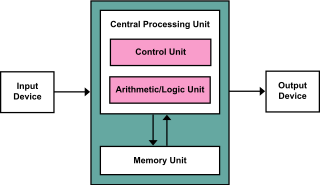
The von Neumann architecture—also known as the von Neumann model or Princeton architecture—is a computer architecture based on a 1945 description by John von Neumann, and by others, in the First Draft of a Report on the EDVAC. The document describes a design architecture for an electronic digital computer with these components:
Wallace John Eckert was an American astronomer, who directed the Thomas J. Watson Astronomical Computing Bureau at Columbia University which evolved into the research division of IBM.

Starting at the end of the nineteenth century, well before the advent of electronic computers, data processing was performed using electromechanical machines collectively referred to as unit record equipment, electric accounting machines (EAM) or tabulating machines. Unit record machines came to be as ubiquitous in industry and government in the first two-thirds of the twentieth century as computers became in the last third. They allowed large volume, sophisticated data-processing tasks to be accomplished before electronic computers were invented and while they were still in their infancy. This data processing was accomplished by processing punched cards through various unit record machines in a carefully choreographed progression. This progression, or flow, from machine to machine was often planned and documented with detailed flowcharts that used standardized symbols for documents and the various machine functions. All but the earliest machines had high-speed mechanical feeders to process cards at rates from around 100 to 2,000 per minute, sensing punched holes with mechanical, electrical, or, later, optical sensors. The operation of many machines was directed by the use of a removable plugboard, control panel, or connection box. Initially all machines were manual or electromechanical. The first use of an electronic component was in 1937 when a photocell was used in a Social Security bill-feed machine. Electronic components were used on other machines beginning in the late 1940s.

The tabulating machine was an electromechanical machine designed to assist in summarizing information stored on punched cards. Invented by Herman Hollerith, the machine was developed to help process data for the 1890 U.S. Census. Later models were widely used for business applications such as accounting and inventory control. It spawned a class of machines, known as unit record equipment, and the data processing industry.

The IBM Selective Sequence Electronic Calculator (SSEC) was an electromechanical computer built by IBM. Its design was started in late 1944 and it operated from January 1948 to August 1952. It had many of the features of a stored-program computer, and was the first operational machine able to treat its instructions as data, but it was not fully electronic. Although the SSEC proved useful for several high-profile applications, it soon became obsolete. As the last large electromechanical computer ever built, its greatest success was the publicity it provided for IBM.

The Harvard Mark III, also known as ADEC was an early computer that was partially electronic and partially electromechanical. It was built at Harvard University under the supervision of Howard Aiken for use at Naval Surface Warfare Center Dahlgren Division.
The Harvard Mark II, also known as the Aiken Relay Calculator, was an electromechanical computer built under the direction of Howard Aiken at Harvard University, completed in 1947. It was financed by the United States Navy and used for ballistic calculations at Naval Proving Ground Dahlgren. Computer pioneers Edmund Berkeley and Grace Hopper worked together under Aiken to build and program the Mark II

The history of computer science began long before the modern discipline of computer science, usually appearing in forms like mathematics or physics. Developments in previous centuries alluded to the discipline that we now know as computer science. This progression, from mechanical inventions and mathematical theories towards modern computer concepts and machines, led to the development of a major academic field, massive technological advancement across the Western world, and the basis of a massive worldwide trade and culture.

A computer is a machine that can be programmed to automatically carry out sequences of arithmetic or logical operations (computation). Modern digital electronic computers can perform generic sets of operations known as programs. These programs enable computers to perform a wide range of tasks. The term computer system may refer to a nominally complete computer that includes the hardware, operating system, software, and peripheral equipment needed and used for full operation; or to a group of computers that are linked and function together, such as a computer network or computer cluster.
James Wares Bryce was an American engineer and inventor. In 1936, on the centenary of the United States Patent Office, he was honored as one of the country’s 10 greatest living inventors.
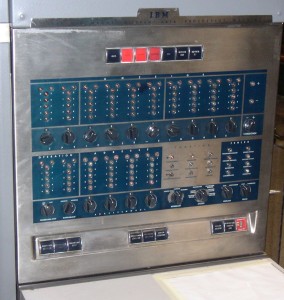
Cuthbert Corwin Hurd was an American computer scientist and entrepreneur, who was instrumental in helping the International Business Machines Corporation develop its first general-purpose computers.

The Model V was among the early electromechanical general purpose computers, designed by George Stibitz and built by Bell Telephone Laboratories, operational in 1946.
Richard Milton Bloch was a pioneering American computer programmer. Bloch, Grace Hopper, and Robert Campbell were the first programmers of the Harvard Mark I, an electromechanical computer which, when it began operation in 1944, was the first American programmable computer.



